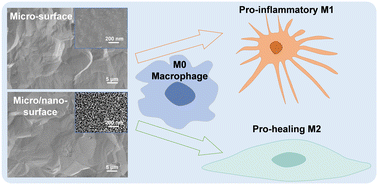The role of nanopores constructed on the micropitted titanium surface in the immune responses of macrophages and the potential mechanisms†
Abstract
The delayed transition of macrophages (MΦs) from pro-inflammatory M1 to the pro-healing M2 state on implant surfaces is one of the most important reasons for poor osseointegration. This work reports the construction of closely packed nanopores with a small diameter on the micropitted titanium (Ti) surface by two-step acid etching to promote the M1-to-M2 transition of MΦs and pays special attention to the potential mechanisms by which the nanopores decorating the micropits exert immunomodulatory effects. The results show that the structure composed of hybrid nanopores (10–25 nm) and micropits (5–15 μm) can be produced on the Ti surface by a two-step acid etching process. Compared with the unitary micropits, the micropit/nanopore surface could facilitate the switch of MΦs from the pro-inflammatory M1 to the pro-healing M2 phenotype. RNA sequencing reveals that the MAPK, PI3K-AKT and C-type lectin signaling pathways play key roles in the micro/nano-structure-mediated transition. In addition, the micro/nano-structured surface down-regulated CYP1A2 expression, reducing the generation of mitochondrial ROS, in turn restraining the oxidative stress and further attenuating inflammation. This work provides novel insights into the underlying mechanisms of immunomodulation by the nano-structure-decorated micro-structures on the Ti surface, which is significant for designing the surface of orthopedic implants from the perspective of immunomodulation.

- This article is part of the themed collection: Journal of Materials Chemistry B HOT Papers


 Please wait while we load your content...
Please wait while we load your content...